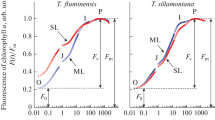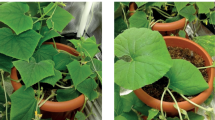Abstract
The heat-sensitivity of photosynthetic oxygen evolution of thylakoids isolated from spinach increases by increasing the pH above neutral value. The temperature for inactivation (transition temperature) is lowered from about 45° C (pH 6.0–7.4) to 33°C (pH 8.5). Similar results are obtained with intact chloroplasts. At pH 7.0 the transition temperature of washed thylakoids decreases by lowering the salt concentration below 20 mM with monovalent cations (Li+, Na+, K+) and below 3–4 mM with divalent cations (Mg2+, Ca2+, Sr2+). Illumination decreases the heat-sensitivity of oxygen evolution in intact chloroplasts, but even increases the heat-sensitivity in uncoupled chloroplasts. In intact chloroplasts the transition temperature of the heat-induced rise in chlorophyll fluorescence yield (Fo; see Schreiber and Armond 1978) decreases from 44° C to 38° C when the pH of the suspending medium is increased from 6.5 to 8.5. At 20° C, Fo is almost insensitive to pH (6.0–8.5). At 40° C, however, Fo is constant between 6.0 and 7.0, but strongly increases by increasing the pH above neutral value. The results are discussed in terms of a close relation between electrostatic forces at the thylakoid membrane and thermal sensitivity of photosynthetic apparatus. It is suggested that the heat-sensitivity of the photosystem II complex partially depends on the ionization state of fixed groups having alkaline pK. The “packed volume” of thylakoids suspended in a low salt medium increases when the temperature is increased above 30° C (pH 7.0) and above 20° C (pH 8.0), respectively. This result suggests a heat-induced increase in surface charge density of the thylakoid membrane.
Similar content being viewed by others
Abbreviations
- HEPES:
-
N-2-hydroxyethylpiperazine-N′-2-ethane sulfonic acid
- MES:
-
morpholinoethane sulfonic acid
- MOPS:
-
2-N-morpholinopropane sulfonic acid
- TRICIN:
-
N-[tris(hydroxymethyl)-methyl] glycine
References
Ageeva, O.G. (1977) Effects of light on thermostability of Hill reaction in pea and spinach chloroplasts. Photosynthetica 11, 1–4
Armond, P.A., Schreiber, U., Björkman, O. (1978) Photosynthetic acclimation to temperature in the desert shrub Larrea divaricata II. Light harvesting efficiency and electron transport. Plant Physiol. 61, 411–415
Berry, J.A., Fork, D.C., Garrison, S. (1975) Mechanistic studies of thermal damage to leaves. Carnegie Inst. Year Book 74, 751–759
Björkman, O. (1975) Thermal stability of the photosynthetic apparatus in intact leaves. Carnegie Inst. Year Book 74, 748–751
Döring, G., Renger, G., Vater, J., Witt, H.T. (1969) Properties of the photoactive chlorophyll-aII in photosynthesis. Z. Naturforsch. 24b, 1139–1143
Heber, U. (1973) Stoichiometry of reduction and phosphorylation during illumination of intact chloroplasts. Biochim. Biophys. Acta 305, 140–152
Hesse, H., Jank-Ladwig, R., Strotmann, H. (1976) On the reconstitution of phosphorylation in CF1-extracted chloroplasts. Z. Naturforsch. 31c, 445–451
Izawa, S., Good, N.E. (1966) Effects of salts and electron transport on the conformation of isolated chloroplasts. II. Electron microscopy. Plant Physiol. 41, 544–552
Jensen, R.G., Bassham, J.A. (1966) Photosynthesis by islolated chloroplasts. Proc. Natl. Acad. Sci. USA 56, 1095–1101
Katoh, S., San Pietro, A. (1967) Ascorbate-supported NADP photoreduction by heated Euglena chloroplasts. Arch. Biochim. Biophys. 122, 144–150
Krause, G.H., Santarius, K.A. (1975) Relative thermostability of the chloroplast envelope. Planta 127, 285–299
Kislyuk, J.M. (1979) Protecting and injurious effects of light on photosynthetic apparatus during and after heat treatment of leaves. Photosynthetica 13: 386–391
Lavorel, J. (1969) On the relation between fluorescence and luminescence in photosynthetic systems. In: Progress in Photosyn. Research, Vol. 2, pp. 883–898 Metzner, H., ed. Int. Union Biol. Sci., Tübingen
Masamoto, H.Y., Itoh, S., Nishimura, M. (1980) Salt-induced pH changes in spinach chloroplast suspension. Changes in surface potential and surface pH of thylakoid membranes. Biochim. Biophys. Acta 591, 142–152
Mukohata, Y., Yagi, T., Higashida, M., Shinozaki, K., Matsuno, A. (1973) Biophysical studies on subcellular particles VI. Photosynthetic activities in isolated spinach chloroplasts after transient warming. Plant Cell Physiol 14, 111–118
Murakami, S., Packer, L. (1970) Protonation and chloroplast membrane structure. J. Cell Biol. 47, 332–351
Murakami, S., Packer, L. (1971) The role of cations in the organization of chloroplast membranes. Arch. Biochim. Biophys. 146, 337–347
Nakatani, H.Y., Barber, J., Forrester, J.A. (1978) Surface charges on chloroplast membranes as studied by particle electrophoresis. Biochim. Biophys. Acta 504, 215–225
Pearcy, R.W., Berry, J.A., Fork, D.C. (1977) Effects of growth on the thermal stability of the photosynthetic apparatus of Atriplex lentiformis (Torr.). Wats. Plant Physiol. 59, 873–878
Reimer, S., Trebst, A. (1975) Light-induced conformational changes of the chloroplast thylakoid membrane as indicated by the inactivation of the oxygen evolution system by high internal pH. Biochim. Physiol. Pflanzen. 168, 225–232
Rubin, B.T., Chow, W.S., Barber, J. (1981) Experimental and theoretical considerations of mechanisms controlling cation effects on thylakoid membrane stacking and chlorophyll fluorescence. Biochim. Biophys. Acta 634, 174–190
Santarius, K.A. (1975) Sites of heat sensitivity in chloroplasts and differential inactivation of cyclic and noncyclic photophosphorylation by heating. J. Therm. Biol. 1, 101–107
Santarius, K.A., Müller, M. (1979) Investigations on heat resistance of spinach leaves. Planta 146, 529–538
Schreiber, U. (1976) Correlation between growth temperature and heat-induced chlorophyll fluorescence changes in Scenedesmus obliquus. Carnegie Inst. Year Book 75, 472–477
Schreiber, U. (1979) Cold-induced uncoupling of energy transfer between phycobilins and chlorophyll in Anacystis nidulans. FEBS Lett. 107, 4–9
Schreiber, U. (1980) Reversible uncoupling of energy transfer between phycobilins and chlorophyll in Anacystis nidulans. Light stimulation of cold-induced phycobilisome detachment. Biochim. Biophys. Acta 591, 361–371
Schreiber, U., Armond, P.A. (1978) Heat induced changes of chlorophyll fluorescence in isolated chloroplasts and related heat damage at the pigment level. Biochim. Biophys. Acta 502, 138–151
Schreiber, U., Berry, J.A. (1977) Heat-induced changes of chlorophyll fluorescence in intact leaves correlated with damage of the photosynthetic apparatus. Planta 136, 233–238
Schreiber, U., Colbow, K., Vidaver, W. (1976) Analysis of temperature jump chlorophyll fluorescence induction in plants. Biochim. Biophys. Acta 423, 249–263
Searle, G.F.W., Barber, J. (1978) The involvement of the electrical double layer in the quenching of 9-aminoacridine fluorescence by negatively charged surfaces. Biochim. Biophys. Acta 502, 309–320
Searle, G.F.W., Barber, J., Mills, J.D. (1977) 9-aminoacridine as a probe of the electrical double layer associated with the chloroplast thylakoid membrane. Biochim. Biophys. Acta 461, 413–425
Telfer, A., Barber, J., Jagendorf, A.T. (1980) Electrostatic control of chloroplast coupling factor binding to thylakoid membrane as indicated by cation effects on electron transport and reconstitution of phosphorylation. Biochim. Biophys. Acta 591, 331–345
Träuble, H., Eibl, H.-J. (1974) Electrostatic effects on lipid phase transitions: Membrane structure and ionic environment. Proc. Natl. Acad. Sci. USA 71, 214–219
Yamashita, T., Butler, W.L. (1969) Inhibition of the Hill reaction by tris and restoration by electron donation to photosystem II. Plant Physiol. 44, 435–458
Author information
Authors and Affiliations
Rights and permissions
About this article
Cite this article
Weis, E. The influence of metal cations and pH on the heat sensitivity of photosynthetic oxygen evolution and chlorophyll fluorescence in spinach chloroplasts. Planta 154, 41–47 (1982). https://doi.org/10.1007/BF00385494
Received:
Accepted:
Issue Date:
DOI: https://doi.org/10.1007/BF00385494




